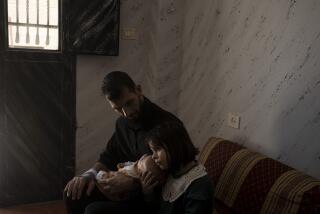Surrendering Iraqis Are ‘Glad to Be Out of Iraq’ : Prisoners: Instead of a worn, depressed enemy, allied forces are finding smiling men with no fight left in them.
ON THE NORTHERN SAUDI BORDER — They were not covered with lice and their boots were less worn than those on GIs, but Iraqi prisoners of war had no fight in them as they were brought south by the hundreds.
“They were glad to be out of Iraq. A couple had grins on their faces; a couple was talking at each other and grinning. . . . They knew they were going somewhere out of Iraq, and they were happy for it,” said Army Sgt. Robert Simpson, 22, of Chattanooga, Tenn., a helicopter flight engineer who brought a load of 43 prisoners from deep in Iraq.
In one sector where French light-armored infantry advanced alongside paratroopers of the American 82nd Airborne Division, 417 prisoners were taken Monday. They were ferried to the rear, across the Saudi Arabian border, to a “holding point,” where witnesses said more than 1,000 prisoners and maybe twice that many are housed in new tents.
As troops of U.S. airborne divisions moved deep into Iraq alongside the French, there was intense curiosity about the growing number of enemy soldiers who were surrendering.
“I wanted to look at my adversary in the face after 20 years in the Army,” said public affairs specialist Lt. Col. Bob Parrich, 40, of Greeley, Colo. He rode the jump-seat in a CH-47 Chinook helicopter during one mission to pick up this “opportunity cargo.”
“It wasn’t what I expected. I expected to see soldiers who had been defeated, drawn and gaunt looks on their faces. I did not see that. I did not see a defeated enemy--I saw a group of people who did not want to be soldiers. I saw people who wanted to be doing something else with their lives.”
Of the 417 prisoners captured in this one sector, four were in need of medical attention--three had shrapnel wounds and the fourth was reported to have drunk diesel fuel.
The others were bound with plastic handcuffs or knotted cloth, marched into the cargo-like helicopters and brought to the holding area.
The prisoners had longer hair than soldiers normally wear, but wore green-ribbed sweaters without holes and boots with little sign of wear. They were not especially thin and showed no signs of disease or illness.
Probably because of the small number of U.S. casualties and the generally light resistance so far in this sector of operations to the west of Kuwait, there was no hostility among Americans as they looked into the eyes of their foe.
“They were like Americans, more or less, only Iraqis,” said Sgt. Simpson. “They’ve just got someone else telling them what to do. They didn’t look aggressive, they didn’t look like they wanted to be out killing anything. They didn’t look like they wanted to do this anymore.”
More to Read
Sign up for Essential California
The most important California stories and recommendations in your inbox every morning.
You may occasionally receive promotional content from the Los Angeles Times.









